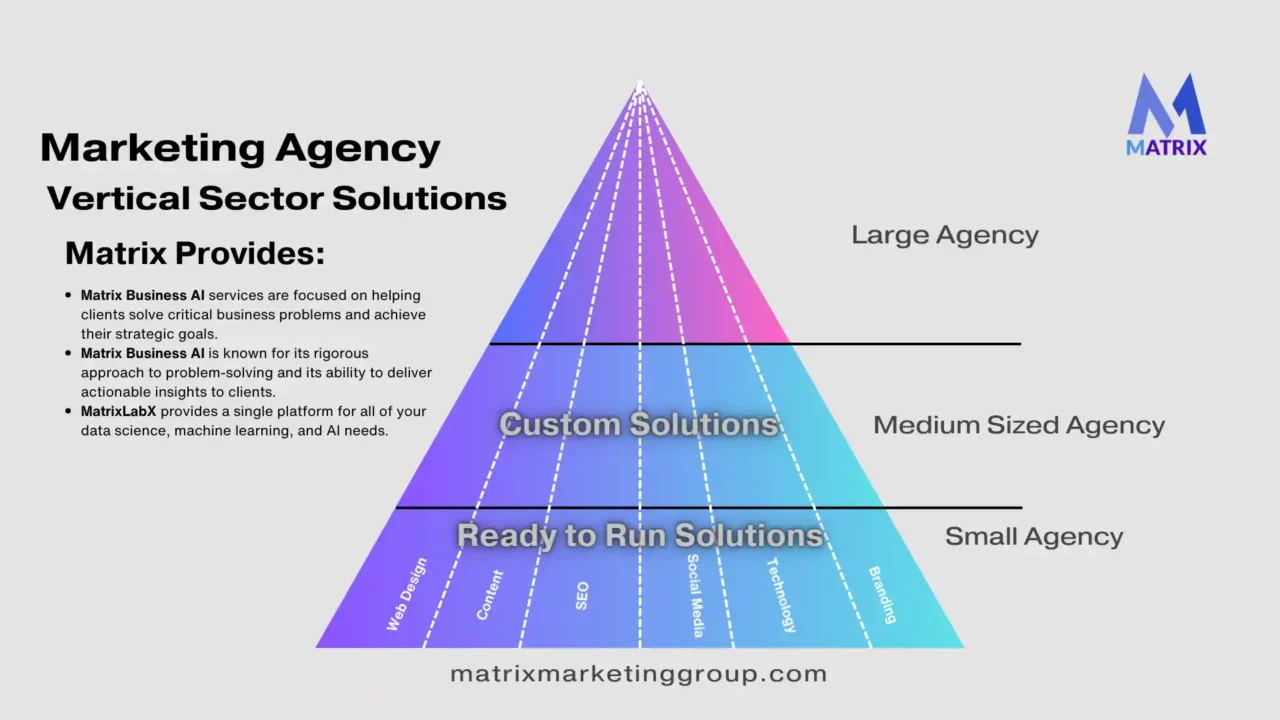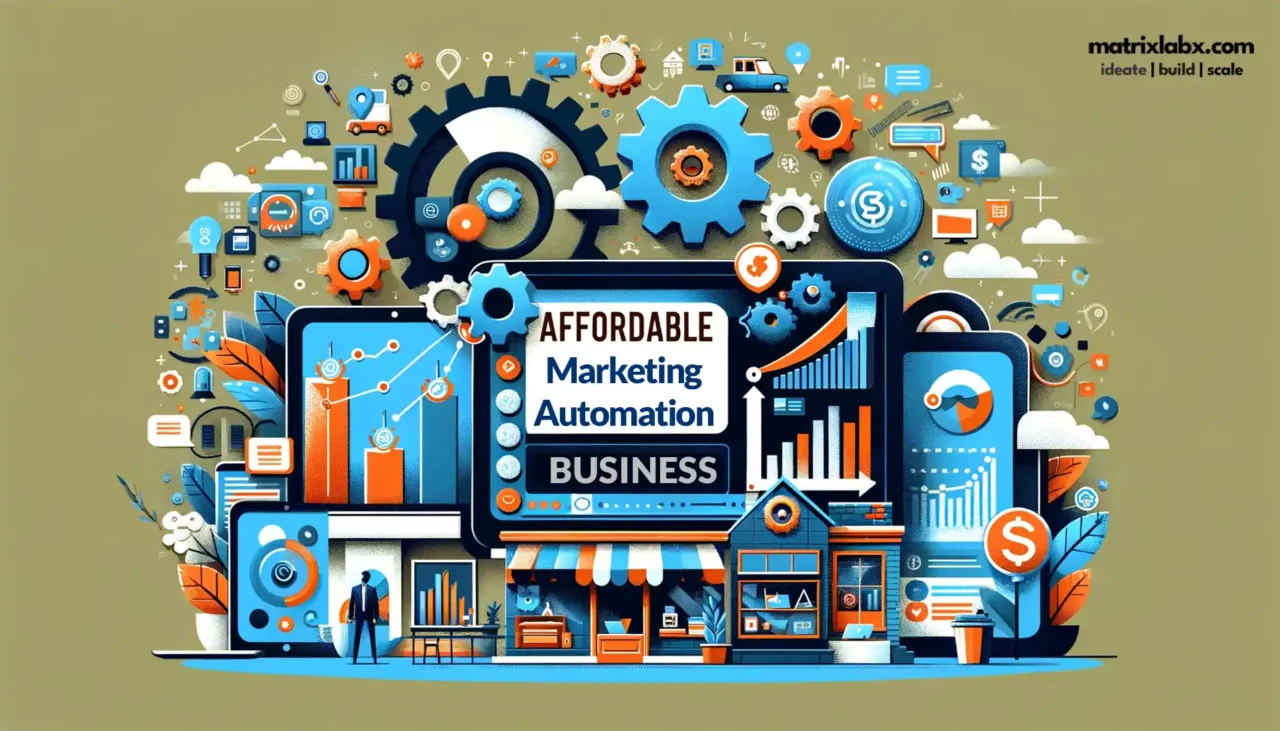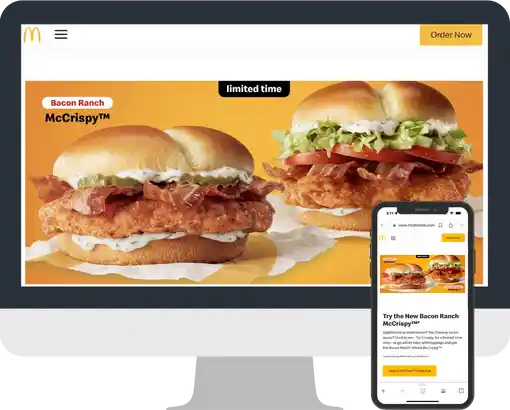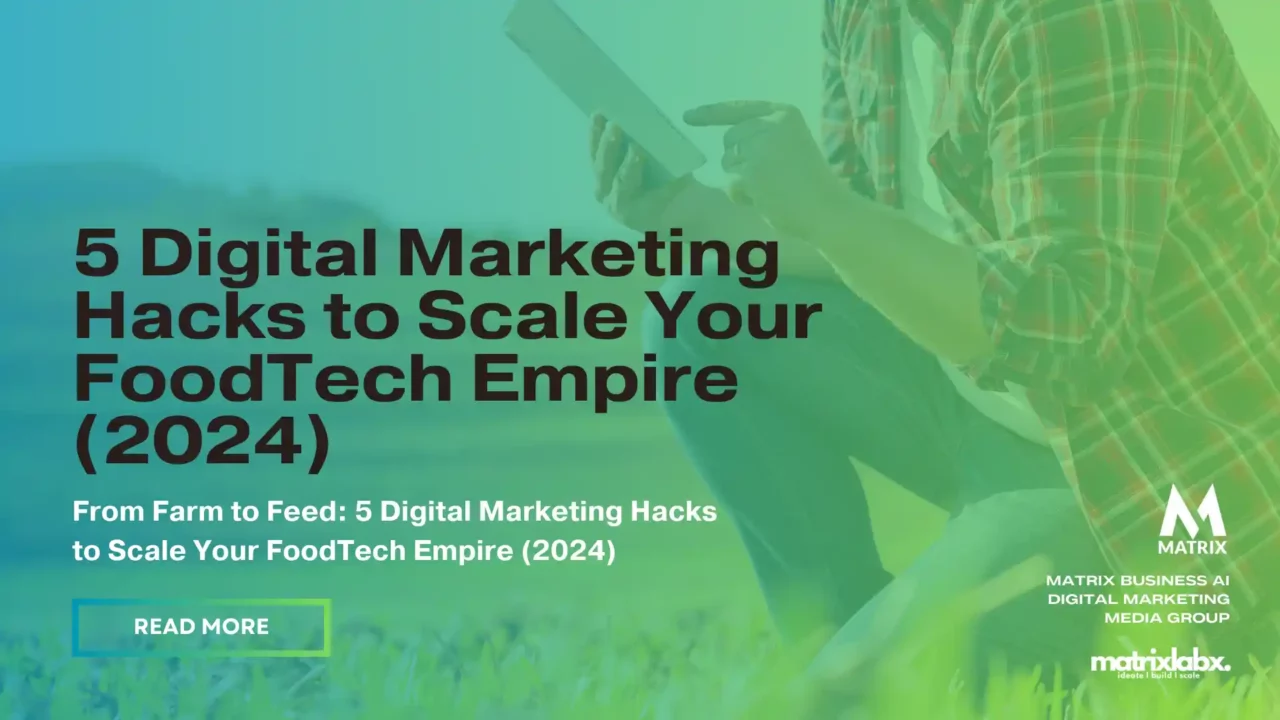From Farm to Feed: 5 Food Tech Digital Marketing Hacks to Scale Your FoodTech Empire (2024)
Learn about the Top 5 Food Tech Digital Marketing Hacks to Scale Your FoodTech Empire (2024)
Embracing the Digital Age in FoodTech
The Dawn of a New Era in Food Technology
The food tech industry is undergoing a revolutionary transformation fueled by the relentless pace of technological advancement.
Traditional food production, marketing, and distribution approaches rapidly evolve in this digital era. Companies at the forefront of this change are not just surviving but thriving, scaling their operations to unimaginable heights.
The secret to their success? A mastery of digital marketing strategies tailored specifically for the FoodTech sector.
Unleashing the Power of Digital Marketing in FoodTech
The fusion of technology and food has created a unique market space where innovation is welcomed and expected.
This intersection presents a unique set of challenges and opportunities for marketers. In the world of FoodTech, understanding and harnessing the power of digital marketing is not just beneficial; it’s essential.
This industry demands strategies that are as innovative and dynamic as the products and services it offers.
Five Digital Marketing Hacks to Transform Your FoodTech Business
But how can a food tech business leverage digital marketing to scale up and outperform the competition?
Adopting powerful yet often overlooked digital marketing hacks is the answer. These strategies are the key to unlocking the full potential of your FoodTech venture.
They’re not just about reaching a wider audience; they’re about engaging with the right audience in the right way.
The Blueprint for Success in the Digital FoodTech Realm
This article delves into the top five digital marketing hacks that can catapult your FoodTech business into a new realm of success.
From leveraging social media platforms to harnessing the power of analytics, these hacks are designed to optimize your marketing efforts and maximize your return on investment. Each strategy is a puzzle, working together to create a comprehensive and effective digital marketing approach.
The Future is Here, and It’s Digital
The food tech industry is at a pivotal point, and the companies that will dominate the future landscape are those that embrace digital marketing.
With these five hacks, you’re not just preparing to participate in the digital revolution but gearing up to lead it. The future of FoodTech is here, and it’s digital. Are you ready to be a part of it?
Here are some intriguing statistics about digital marketing in the FoodTech industry that are not commonly discussed:
- Sustainability Initiatives in Packaging: Innovations in sustainable packaging are gaining traction. In product manufacturing, Companies use organic waste materials like coffee husk, alginate, oyster shells, and paper waste. Notable initiatives include Junai, specializing in regenerative material development, and Huskee, which makes products from coffee husk bio-polymers and has launched HuskeeSwap to eliminate single-use takeaway cups.
- Shift Towards Higher Protein Foods: Increasing investment in high-protein foods, originally a trend in sports nutrition, is now expanding into the broader food space. This trend highlights the untapped potential in the food industry, driven by consumer interest in healthier options.
- Mobile Commerce and Digital Marketing: In digital marketing, the performance of mobile websites is crucial. Bounce rates on m-commerce websites increase by 32% when loading times go from 1 to 3 seconds. Additionally, mobile application conversion rates are 3 times higher than mobile websites, and over 70% of online buyers prefer well-optimized websites that offer a smoother shopping experience.
- SEO and Content Marketing: The SEO industry is valued at over $50 billion in 2024, with organic traffic responsible for 53% of traffic to all websites. Brands with dedicated blogs see 55% more traffic than those without. Furthermore, most consumers (86%) ignore paid advertisements, emphasizing the importance of organic search and content marketing for driving traffic and sales.
- Challenges in the Foodtech Market: The Foodtech market faces challenges, including balancing taste with health concerns in ultra-processed foods and greater food safety and traceability. This has led to an increased focus on digital transformation within the industry as companies strive to meet these challenges while adhering to evolving consumer preferences and regulatory requirements.
These statistics reveal the dynamic nature of the FoodTech industry, highlighting the importance of sustainable practices, consumer health trends, and the critical role of digital marketing and SEO in driving business growth.
Navigating the Maze: SEO Challenges in FoodTech Marketing
The Balancing Act of Relevance and Optimization
In the dynamic world of FoodTech, aligning content with marketing strategies presents unique challenges, especially in Search Engine Optimization (SEO).
These challenges can significantly impact a company’s online visibility and customer engagement. Understanding these hurdles is crucial for SEO managers to navigate effectively.
1. Complex Keyword Landscape
The FoodTech industry, being diverse and ever-evolving, presents a complex keyword landscape for SEO. With topics ranging from sustainable food production to innovative food delivery models, identifying the right keywords that resonate with industry trends and consumer interests is daunting. This complexity is further heightened by the rapid emergence of new technologies and consumer preferences, which can shift the focus and relevance of keywords almost overnight.
Challenge Implication: SEO managers must continuously research and adapt their keyword strategies to stay relevant. This involves not only understanding the current market but also anticipating future trends.
2. High-Quality, Engaging Content Conundrum
Creating high-quality, engaging content is vital for effective SEO, but in the FoodTech sector, this is a particularly intricate puzzle. Content must be informative, relevant, engaging, and accessible to a broad audience. This challenge is compounded by the need to address complex scientific and technological concepts in a manner that is accurate and understandable to the average consumer.
Challenge Implication: SEO managers need to strike a delicate balance between technical accuracy and readability. Collaborating with subject matter experts and content creators is essential to produce content that is both informative and appealing.
3. Evolving Search Algorithms and User Behavior
Search engines continuously evolve their algorithms, significantly affecting how FoodTech content is ranked and discovered. These changes can render previous SEO strategies less effective, requiring constant adaptation. Additionally, user behavior in searching and consuming FoodTech information is also in flux, influenced by global trends, health concerns, and technological advancements.
Challenge Implication: SEO managers must stay abreast of algorithm changes and user behavior shifts. Regular analysis of search patterns, user engagement metrics, and industry trends is vital to refine SEO strategies.
Towards a Sustainable SEO Strategy
To overcome these challenges, a sustainable, flexible SEO strategy is essential. This involves continuous learning, adaptation, and a deep understanding of the FoodTech industry’s unique landscape. By embracing these challenges, SEO managers can effectively navigate the complex web of FoodTech marketing, ensuring their content resonates with and reaches the intended audience.
In conclusion, the intersection of FoodTech and digital marketing presents a unique set of challenges for SEO management. By acknowledging and addressing these complexities, companies can enhance their online presence, engage effectively with their audience, and stay ahead in the competitive food tech industry.
I can’t access or retrieve content from specific blogs or articles, including the one titled “Align content with food tech firms.” However, I can create an informative and engaging piece based on the general theme of aligning content with FoodTech firms. This will cover the who, what, where, when, and why aspects, considering the typical challenges and strategies involved in content alignment within the food tech industry.
Decoding the Synergy: Aligning Content with FoodTech Firms

Who is Involved: The Collaborative Effort
In the world of FoodTech, content alignment is a dance that involves multiple partners. This includes content creators, marketing strategists, SEO specialists, and FoodTech experts. Each plays a vital role.
The content creators craft engaging narratives, marketing strategists align these narratives with brand goals, SEO specialists ensure the content reaches its intended audience, and FoodTech experts provide the essential knowledge that makes the content both informative and credible.
What it Involves: Crafting a Unified Message
Content alignment in FoodTech is about creating a unified message that resonates with the industry’s innovative spirit and the consumers’ growing awareness and expectations.
This involves producing engaging, informative content that reflects the latest trends and advancements in food technology, such as sustainable practices, nutritional advancements, and technological innovations in food production and distribution.
Where it Happens: Platforms and Channels
The digital landscape is the playground for this content. From company blogs and social media platforms to online forums and digital marketing campaigns, these are the stages where content alignment plays out.
Each platform offers a unique way to engage with different audience segments, requiring tailored content strategies to communicate the brand’s message and values effectively.
When it Strikes a Chord: Timeliness and Relevance
Timing is everything. Aligning content with current trends, seasonal demands, or emerging technologies can significantly enhance its impact.
For instance, aligning content with global events like World Environment Day or technological breakthroughs in the FoodTech industry can greatly increase relevance and audience engagement.
Why it Matters: The Purpose Behind the Content
At its core, aligning content with FoodTech firms is about building a bridge between innovation and the consumer.
It’s about educating, informing, and inspiring audiences. Whether it’s about promoting healthier food options, advocating for sustainable food production, or showcasing the latest in food technology, the content connects the industry’s advancements with the consumers’ values and lifestyles.
The Art of Alignment

In essence, aligning content with FoodTech firms is an art that requires a deep understanding of both the industry and its audience. It’s about creating a harmonious blend of information, engagement, and inspiration.
By mastering this art, FoodTech firms can elevate their brand and contribute to a more informed and conscious consumer base.
This overview provides a general idea of how content alignment works in the FoodTech industry, covering the key aspects of who is involved, what it entails, where it happens, when it is most effective, and why it is crucial.
Creating engaging use cases from aligning content with FoodTech firms can illustrate the power and impact of effective content marketing strategies.
Here are three hypothetical scenarios, formatted in the Before-After-Bridge (BAB) structure, to demonstrate how this alignment can transform a food tech firm’s outreach and engagement.
1. Sustainable Farming Tech Company
A sustainable farming technology company needed help communicating the benefits of its innovative hydroponic systems. Their technical jargon could have been more manageable for the average consumer, leading to low engagement and limited brand awareness.
By aligning their content with the values and interests of their audience, the company saw a significant increase in engagement. They simplified their language, focusing on their systems’ environmental benefits and ease of use.
The company achieved this transformation by working with content creators specializing in environmental technology. They crafted stories that highlighted the personal and global benefits of sustainable farming, using relatable examples and easy-to-understand terms. This approach helped the audience grasp the significance of the technology, leading to increased interest and sales.
2. Plant-Based Protein Startup
A startup focused on plant-based proteins was lost in the crowded market. Despite having a superior product, they could have effectively communicated its benefits and uniqueness to health-conscious consumers.
The startup repositioned itself by aligning its content strategy with the lifestyle and values of its target audience. They started producing content that talked about the product and provided value through healthy recipes, nutrition tips, and environmental impact information.
The key was to create engaging, informative content that resonated with the audience’s desire for healthier, sustainable food choices. By sharing success stories of individuals benefiting from plant-based diets and highlighting the environmental advantages of their products, the startup managed to build a loyal community of advocates and customers.
3. Food Delivery App Focusing on Local Cuisines
A food delivery app specializing in local cuisines needed help to differentiate itself in a market dominated by large players. Their unique selling point of supporting local businesses and promoting regional cuisines could have been more effectively communicated to the target audience.
After realigning their content strategy, the app saw a significant boost in user engagement and downloads.
They focused on telling the stories of local chefs and restaurants, highlighting the cultural richness and authenticity of the cuisines offered.
This shift was achieved by collaborating with local food bloggers and influencers to create content celebrating regional culinary traditions.
By showcasing the stories behind the local eateries and their dishes, the app connected with users on a more personal level, driving interest and loyalty towards the app and its mission.
In conclusion, these use cases demonstrate the transformative power of aligning content with the core values and interests of a food tech firm’s target audience.
By understanding and addressing the needs and preferences of their audience, FoodTech companies can significantly enhance their brand presence and customer engagement.
“From Farm to Feed: 5 Digital Marketing Hacks to Scale Your FoodTech Empire (2024)” likely offers valuable insights for FoodTech companies looking to enhance their digital marketing strategies.
While I can’t access the specific content of the blog, I can provide a hypothetical step-by-step guide based on common digital marketing practices tailored for FoodTech companies. This guide aims to spark your curiosity and provide a framework that you can adapt to your unique situation.
Embracing the Digital Harvest: A Guide to Food Tech Marketing Success

Step-by-Step Implementation:
1. Know Your Field: Market Research and Audience Identification
- Research Your Market: Dive deep into understanding the FoodTech landscape, including trends, competitor strategies, and consumer behavior.
- Identify Your Audience: Define your target audience’s demographics, preferences, and needs. Use surveys, social media insights, and customer feedback for precise targeting.
2. Planting Seeds of Engagement: Developing a Content Strategy
- Content Creation: Develop a content calendar that aligns with your audience’s interests and seasonal trends in the food tech industry.
- Diverse Formats: Utilize various content formats like blogs, videos, infographics, and podcasts to keep your audience engaged.
- Educational and Engaging: Ensure your content educates about your products while also entertaining, using storytelling to make complex FoodTech concepts relatable.
3. Fertilizing Growth: SEO Optimization
- Keyword Research: Identify keywords related to FoodTech that your target audience frequently searches for.
- On-Page SEO: Optimize your website’s content with these keywords, ensuring they are naturally integrated into titles, headings, and meta descriptions.
- Off-Page SEO: Build backlinks by collaborating with FoodTech influencers and guest posting on relevant websites.
4. Irrigating the Digital Landscape: Social Media and Email Marketing
- Social Media Strategy: Choose platforms where your audience is most active. Regularly post engaging content, interact with followers, and use features like stories and live sessions to boost engagement.
- Email Marketing: Develop a segmented email list. Send personalized newsletters, product updates, and exclusive offers to nurture leads and retain customers.
5. Harvesting Data: Analytics and Adaptation
- Data Analysis: Use tools like Google Analytics to track website traffic, user behavior, and campaign performance.
- Adapt and Evolve: Regularly review your marketing strategies based on analytics. Be prepared to adapt tactics to align with changing consumer preferences and industry trends.

Cultivating a Robust FoodTech Empire
Implementing these digital marketing strategies requires a balance of creativity, analytical thinking, and a deep understanding of the food tech industry.
By following these steps, you can create a dynamic and effective digital marketing plan that resonates with your audience, strengthens your brand presence, and ultimately scales your FoodTech business.
Remember, digital marketing is an evolving field, and staying updated with the latest trends and tools is crucial for ongoing success. Each step should be part of a continuous learning process, experimenting and refining your approach to suit the ever-changing digital landscape.
“From Farm to Feed: 5 Digital Marketing Hacks to Scale Your FoodTech Empire (2024)” is a compelling blog post that offers a deep dive into innovative digital marketing strategies tailored for the burgeoning FoodTech sector.
Its core message revolves around leveraging digital tools and techniques to amplify a FoodTech business’s reach and impact. Let’s explore the key takeaways and how they offer a competitive edge to businesses in this dynamic industry.
Harnessing Digital Power: Key Strategies from the Blog
1. Embracing Market Research and Audience Targeting The blog emphasizes the importance of understanding the market landscape and identifying the target audience. This step forms the backbone of any successful digital marketing campaign, ensuring that efforts are directed at those most likely to engage with the brand.
2. Content Is King: Crafting a Winning Content Strategy Another crucial aspect highlighted is developing a content strategy that resonates with the audience. The blog advises creating a mix of educational and engaging content that informs and entertains, helping to establish a strong brand presence and credibility.
3. SEO: The Gateway to Visibility Optimizing content for search engines is a game-changer, as the post details. By strategically using SEO, businesses can significantly increase their online visibility, drawing more traffic to their website and increasing the potential for conversions.
4. The Social Media and Email Marketing Symphony The power of social media and email marketing is another focal point. The blog outlines how these platforms can nurture leads, engage with customers, and build a loyal community around the brand.
5. Data-Driven Decisions: Leveraging Analytics Finally, the blog highlights the importance of analytics in guiding and refining marketing strategies. Businesses can make data-driven decisions to optimize their marketing efforts by understanding user behavior and campaign performance.
Competitive Advantages: Standing Out in the FoodTech Arena
By implementing these digital marketing hacks, FoodTech companies can enjoy a range of competitive advantages:
Increased Brand Awareness and Reach: Adopting these strategies can exponentially increase a brand’s visibility, helping it reach a wider audience. This expanded reach is crucial in the highly competitive FoodTech market.
Enhanced Customer Engagement and Loyalty Through targeted content and personalized marketing efforts, businesses can foster deeper connections with their audience, increasing customer loyalty and repeat business.
Data-Driven Insights for Growth The use of analytics ensures that businesses are not operating in the dark. Insights gained from data help in making informed decisions and fine-tuning marketing strategies for better performance.
Staying Ahead of the Curve The digital marketing landscape is ever-evolving. As the blog suggests, food tech companies can maintain a competitive edge by staying updated with the latest trends and tools.

Better Search Ranking
Better Search Ranking in 90 days
SEO is extremely important for companies to rank well in search engines because it is the primary way that people find information online.
Conclusion: A Recipe for Digital Success
In summary, “From Farm to Feed: 5 Digital Marketing Hacks to Scale Your FoodTech Empire (2024)” provides a comprehensive roadmap for food tech businesses looking to leverage digital marketing for growth and success.
By understanding and implementing these strategies, businesses can enhance their online presence, connect more effectively with their audience, and navigate the competitive landscape of the food tech industry with greater confidence and capability.

